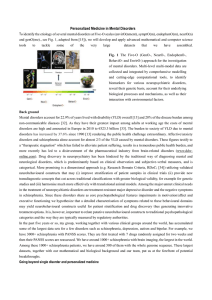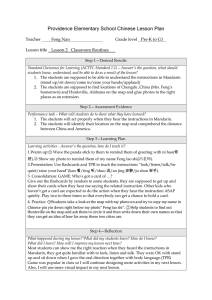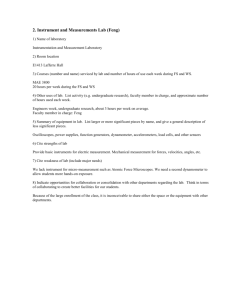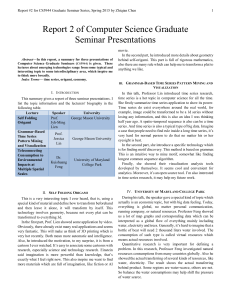Linking Biomarkers at Different Scales in Mental Disorders
advertisement
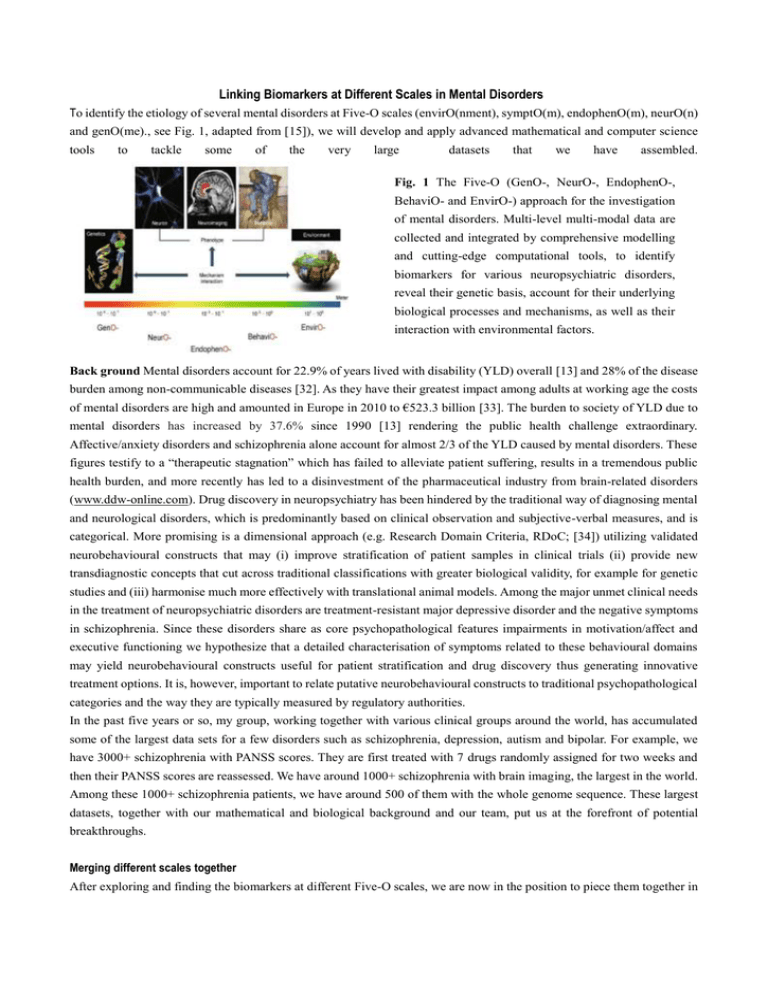
Linking Biomarkers at Different Scales in Mental Disorders To identify the etiology of several mental disorders at Five-O scales (envirO(nment), symptO(m), endophenO(m), neurO(n) and genO(me)., see Fig. 1, adapted from [15]), we will develop and apply advanced mathematical and computer science tools to tackle some of the very large datasets that we have assembled. Fig. 1 The Five-O (GenO-, NeurO-, EndophenO-, BehaviO- and EnvirO-) approach for the investigation of mental disorders. Multi-level multi-modal data are collected and integrated by comprehensive modelling and cutting-edge computational tools, to identify biomarkers for various neuropsychiatric disorders, reveal their genetic basis, account for their underlying biological processes and mechanisms, as well as their interaction with environmental factors. Back ground Mental disorders account for 22.9% of years lived with disability (YLD) overall [13] and 28% of the disease burden among non-communicable diseases [32]. As they have their greatest impact among adults at working age the costs of mental disorders are high and amounted in Europe in 2010 to €523.3 billion [33]. The burden to society of YLD due to mental disorders has increased by 37.6% since 1990 [13] rendering the public health challenge extraordinary. Affective/anxiety disorders and schizophrenia alone account for almost 2/3 of the YLD caused by mental disorders. These figures testify to a “therapeutic stagnation” which has failed to alleviate patient suffering, results in a tremendous public health burden, and more recently has led to a disinvestment of the pharmaceutical industry from brain-related disorders (www.ddw-online.com). Drug discovery in neuropsychiatry has been hindered by the traditional way of diagnosing mental and neurological disorders, which is predominantly based on clinical observation and subjective-verbal measures, and is categorical. More promising is a dimensional approach (e.g. Research Domain Criteria, RDoC; [34]) utilizing validated neurobehavioural constructs that may (i) improve stratification of patient samples in clinical trials (ii) provide new transdiagnostic concepts that cut across traditional classifications with greater biological validity, for example for genetic studies and (iii) harmonise much more effectively with translational animal models. Among the major unmet clinical needs in the treatment of neuropsychiatric disorders are treatment-resistant major depressive disorder and the negative symptoms in schizophrenia. Since these disorders share as core psychopathological features impairments in motivation/affect and executive functioning we hypothesize that a detailed characterisation of symptoms related to these behavioural domains may yield neurobehavioural constructs useful for patient stratification and drug discovery thus generating innovative treatment options. It is, however, important to relate putative neurobehavioural constructs to traditional psychopathological categories and the way they are typically measured by regulatory authorities. In the past five years or so, my group, working together with various clinical groups around the world, has accumulated some of the largest data sets for a few disorders such as schizophrenia, depression, autism and bipolar. For example, we have 3000+ schizophrenia with PANSS scores. They are first treated with 7 drugs randomly assigned for two weeks and then their PANSS scores are reassessed. We have around 1000+ schizophrenia with brain imaging, the largest in the world. Among these 1000+ schizophrenia patients, we have around 500 of them with the whole genome sequence. These largest datasets, together with our mathematical and biological background and our team, put us at the forefront of potential breakthroughs. Merging different scales together After exploring and finding the biomarkers at different Five-O scales, we are now in the position to piece them together in the proposed new research. We have worked on similar but simpler issues for the past few years [5,14,18]. One of the examples is the following, which demonstrate how we can work to combine analyses at different scales. Common variants in the oxytocin receptor-gene (OXTR) are known to influence social and affective behaviour, and to moderate the effect of adverse experiences on risk for social-affective problems. Whereas human functional neuroimaging studies have reported that oxytocin effects on social behaviour and emotional states are mediated by amygdala function, animal models indicate that oxytocin-receptors in the ventral striatum modulate sensitivity to social reinforcers. We aimed Fig. 2[18]. Using behavioral, neuroimaging, and genetic data, we have shown the relationship between OXTR, mental problems, brain activation and environment. We expect to have similar results for the subtype at the different scales. to comprehensively investigate OXTR-dependent brain mechanisms associated with social-affective problems. In a sample of 1,445 adolescents we tested the effect of 23-tagging SNPs across the OXTR region and stressful life events (SLE) on fMRI activity in the ventral striatum (VS) and amygdala to animated angry faces. SNPs for which genewide significant effects on brain function were found were then carried forward to examine associations with social-affective problems. A gene-wide significant effect of rs237915 showed that adolescents with minor CC-genotype had significantly lower VS activity than CT/TT-carriers. Significant or nominally significant GxE effects on emotional problems (in girls) and peer problems (in boys) revealed a strong increase in clinical symptoms as a function of SLEs in CT/TT-carriers but not CChomozygotes. However, in low-SLE environments, CC-homozygotes had more emotional problems (girls) and peer problems (boys). Among CC-homozygotes, reduced VS activity was related to more peer problems. These findings suggest that a common OXTR-variant affects brain responsiveness to negative social cues, and that in “risk-carriers” reduced sensitivity is simultaneously associated with more social-affective problems in “favourable environments” and greater resilience against stressful experiences. Despite the fact that we have not worked on establishing the triangular relationship on biomarkers in mental disorders as shown in Fig. 2 [14,18], we are confident that we can link data at the different Five-O scales to greatly improve exploring biomarkers of mental disorders, which is an aim of the current proposal. For the current project, the student will get familiar with how to establish the triangle relationship based upon one of our papers [9]. In the paper we have established that the functional link between two brain regions (thalamus and postcentral gyrus) has changed most significantly. The link is correlated with the behavior of abstract thinking. We lack the genetic side of the triangle. Using some dataset we have currently, the student will establish the triangle relationship for schizophrenia. References (Full papers of mine can be downloaded from my homepage http://www.dcs.warwick.ac.uk/~feng. Papers from my group are indicated by *) [1]* W Pu, et al. (2016). Psychological Medicine (accepted) [2]* H Cui, et al. (2016). Human Brain Mapping (accepted) [3]* CY Tao, J Feng (2016). J. Neurosci Methods (accepted) [4]* KC Kadosh et al. (2015). NeuroImage , doi:10.1016/j.neuroimage.2015.09.070 [5]* S A. Ojelade, et al. (2015). PNAS , doi:10.1073/pnas.1417222112 [6]* Yao Y, et al. J Feng (2015). Human Brain Mapping DOI: 10.1002/hbm.22932 [7]* Jia TY, et al. (2016). The neural basis of reward anticipation and its genetic determinants PNAS (in press) [8] http://www.imagemend.eu/ [9]* Cheng W, et al. J. Feng (2015). Nature Partner Journal Schizophrenia , doi:10.1038/npjschz.2015.16, Featured Article [10]* Cheng W, Rolls ET, Gu HG, Zhang J, J Feng (2015). Brain vol. 138; 1382--1393, doi: 10.1093/brain/awv051, Editor's Choice., [11]* S Guo, S et al. L Palaniyappan (2015). B J Psychiatry doi:10.1192/bjp.bp.114.15579. [12]* Zhang J, et al J Feng (2014). Cerebral Cortex doi:10.1093/cercor/bhu173. [13] Whiteford HA, et al.(2013) Lancet.;382(9904):1575-86. [14]* S Desrivieres, et al. J Feng, G Schumann (2014). Molecular Psychiatry doi:10.1038/mp.2013.197 [15]* T Ge, G Schumann, J Feng (2013). Quantitative Biology DOI: 10.1007/s40484-013-0023-1 [16]* X. Gan, et al J Feng (2015). J. Neurosci Methods doi:10.1016/j.jneumeth.2015.02.010 [17]* S Guo, S et al. J Feng (2013). Schizophrenia Bulletins doi:10.1093/schbul/sbt163. [18]* Loth E. et al. Feng J , Schumann G. (2013). Biol. Psychiatry doi:10.1016/j.biopsych.2013.07.043. [19]* Luo Q et al. (2013). PLoS Comp Biol DOI: 10.1371/journal.pcbi.1003265, [20]* Guo SX, et al. Feng J (2013). NeuroImage DOI: 10.1016/j.nicl.2013.06. 008. [21]* Chen D., Feng J.F.,and Qian M.(1997) Science in China series A vol. 40: 1129-1135. [22]* Q Luo,et al. Feng J (2013). NeuroImage 79: 241—26. [23]* Feng J.F.,Shcherbina M. and Tirozzi B.(2001) Communications in Mathematical Physics vol. 216, 139-177. [24]* T Ge; J Feng; D Hibar; P Thompson; T Nichols (2012). NeuroImage vol. 63: 858-873 [25]* Cheng W. Rolls E., Feng JF (2016) Depression, in preparation [26]* HJ Tao, et al. JF Feng (2011). Molecular Psychiatry doi:10.1038/mp.2011.127 [27]* Rossoni E., Feng J.F., et al. (2008) PLoS Comp. Biol. 4(7): e1000123. doi:10.1371/journal.pcbi.1000123 [28]* Feng J.F.(1997) Phys. Rev. Lett vol. 79(21), 4505-4508. [29]* Brown D.,Feng J.F., and Feerick S.(1999) Phys. Rev. Lett vol 82, 4731-4734. [30]* Feng J.F.,and Tuckwell H.C.(2003) Phys. Rev. Letts. vol. 91, 018101 [31]* Zhang J., et al. Feng JF (2016) The original of schizophrenia: a big bang theory, in preparation. [32] Prince M, et al.. Lancet. 2007;370(9590):859-77. [33] Gustavsson A, et al. European neuropsychopharmacology. 2011;21(10):718-79. [34]. Abbot, A. Schizophrenia: Nature. 2010;468(7321):158-9
